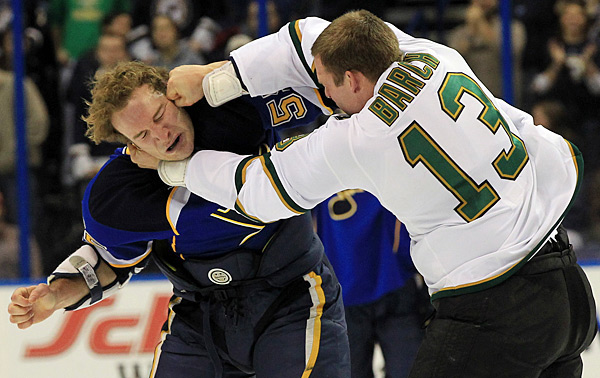
NHL vulnerable to NFL concussion lawsuit
Fighting is just one form of neurologically dangerous behavior the NHL allows. (Bill Greenblatt-UPI/Landov)
By Stu Hackel
Will the recent class action suit by former NFL players -- who allege that their league trained players to hit with their heads, failed to properly treat them for concussions and tried to conceal for decades any links between football and brain injuries -- have an impact on the National Hockey League? One player agent thinks so.
Massachusetts-based Kent Hughes, whose NHL clients include Patrice Bergeron, Peter Mueller and Matthew Lombardi, who have suffered severe concussions, told Mathias Brunet of La Presse that the lawsuit "opens up a can of worms" for the NHL. "I feel that the NHL will closely monitor what happens in the NFL," said Hughes.
A big part of that can of worms has to do with fighting in the NHL.
Of course, the mere filing of a lawsuit is not proof of guilt. Much will have to happen before the NFL is found to have any culpability in the epidemic of concussions that has plagued not just pro football, but the game at all levels. Still, if the NFL knowingly encouraged certain concussion-causing activities while being aware of the dangers, there could be repercussions in hockey.
The discovery of the progressive degenerative brain disease Chronic Traumatic Encephalopathy (CTE) in former NHLers Reg Fleming and Bob Probert has given rise to the belief that fighters who suffer repeated concussions are vulnerable to CTE.
Just how strong the connection is between fighting and CTE may not be definitively known with such a small sample of cases, but a number of medical professionals have called for the end of fighting in the NHL because, even in the absence of more research, what they already know leads them to believe that enforcers have an increased risk of developing the long-term mental and emotional problems associated with CTE.
While the NHL has been more aggressive than other leagues in studying concussions and changing some of its rules accordingly, it has yet to heed the doctors' advice on the issue of fighting. The league would, however, most certainly listen to lawyers and the rulings of judges.
Should the NFL players lawsuit ultimately be successful, the NHL could also be the target of a similar lawsuit. All it would take is a lawyer somewhere who believes that he can make a case that the league has ignored medical evidence and knowingly permitted activity that directly leads to brain trauma. He'd round up a few former players as plaintiffs and proceed.
And it's not just fighting that makes the NHL vulnerable. Rules remain that allow bodycheckers to deliberately target the head of an opponent. Legal head contact has been largely curtailed for the 2011-12 season with the strengthening of Rule 48, but some deliberate contact to the head is still permitted. additionally, the NHL has not made much progress in mandating that players wear softer shoulder and elbow pads.
Additionally, the NHL has inexcusably dragged its skates changing from the more rigid seamless glass to a more flexible system. A player going head-first (or even shoulder-first) into seamless glass is being propelled into something that feels like a brick wall compared to the system of independent glass sections atop the boards that was the universal standard until 1996. The dangers of seamless glass were raised as early as the 1997 All-Star Game when a number of players spoke out, including Brendan Shanahan, who is now the NHL executive in charge of player safety.
Shanahan repeated his objection during a Sports Illustrated roundtable prior to the 2000-01 season. Eventually responding to these concerns, the league targeted Dec. 31, 2002 as the date for teams to not remove the seamless glass but make the system more flexible. Then it extended the deadline until the start of the 2003-04 campaign. Part of the problem was the changeover fee, which reportedly ran as high as $200,000.
In 2002, Mike Modano of the Stars suffered one of his many concussions when the Jeremy Roenick of the Flyers hit him from behind into seamless glass and caused this angry reaction: “The glass is a real issue. What’s the cost? It shows you how important the players are. It’s just a meat market. Move them in and move them out. Get some younger guys whose brains aren’t scrambled yet.”
All the seamless glass is finally supposed to be out of NHL arenas this coming season, a move that was merely 15 years in the making.
There has indisputably been progress in hockey on the issue of preventing concussions and making the game safer in general. "I already felt a greater sensitivity on the part of the teams," Kent Hughes told Brunet, saying he feels there is a greater sensitivity on the league's part to concussions and that it was evident at last week's Research, Development and Orientation Camp. The NHL experimented with rounded glass near the players' benches, a direct outcome of last year's incident in which Boston's Zdeno Chara directed Montreal's Max Pacioretty head-first into a barely padded glass support. But that doesn't mean the NHL has always moved swiftly in these matters or does so in every area.
As for the fights, Hughes said, "I would not be surprised if they disappear if it's proven they are harmful to the brain."
































